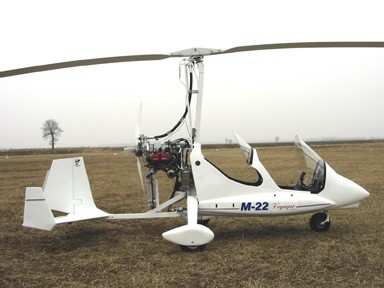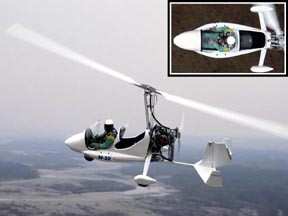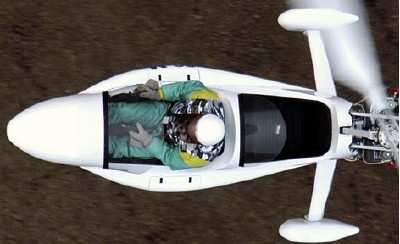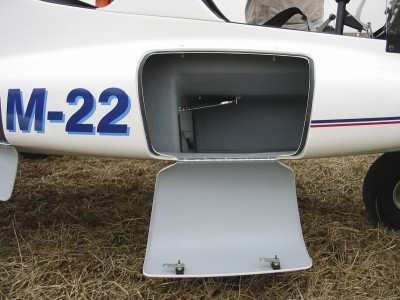Well... They Introduced It, Uh, Like Last Month
by Aero-News Senior Procrastinator Kevin "Hognose" O'Brien
Nothing like getting caught napping, and I got caught napping by
the Magni M-22 announcement back in June. I noticed it, said, "I
oughta write this up," and... there things sat.

And would still have been sitting, if I hadn't taken a more or
less random look at the Magni USA website before going to Oshkosh,
and been reminded of the new Magni Gyro M-22. Magni doesn't
introduce new gyro models frequently, so it pays to take notice
when they do.
The new M-22 Voyager gyro is optimized for cross-country flight;
it's a two-seat tandem, open gyro with decent windshields, and no
controls in the passenger seat. That's one difference from Magni's
flagship M-16 Trainer. The M-22 also has more space for baggage, in
sponsons or "strakes" along the composite fuselage, and only comes
with the turbocharged Rotax 914 engine.
The cargo space extends under the seats of the aircraft. Because
the passenger (back) seat is elevated, there is quite a bit of
luggage space in the M-22 -- more than five cubic feet, according
to Magni.

The M-22 is clearly related to Magni's well-established trainer,
the M-16, familiar to fly-in attendees from importer Greg
Gremminger's much-traveled red, white and blue example, which Greg
routinely flies to the major fly-ins from his Missouri home base.
The machine also was seen by lots of people who don't follow the
gyroplane community, when Greg's sanitary (in California hot rod
jargon of the sixties) example was on the cover of
The -16 and -22 do look very similar, but they aren't
interchangeable -- Magni Gyro warns that you can't add the M-22
baggage pods to the -16, and you definitely can't add dual controls
to the M-22 -- the space the rear seat control mechanisms would use
is now dedicated to baggage.
The longtime gyro aficionado may see something familiar about
the Magni design. Vittorio Magni is a longtime friend and associate
of Finnish gyro pioneer Jukka Tervamaki, and so some of Tervamaki's
design and construction practice filters into Magni's ships.

Magnis are made in Italy, which for Americans is a good news/bad
news thing. The good news is that they have the attention to design
detail and build quality of an Armani suit or a Lamborghini. And
this quality is even affordable -- if you are in Europe; the bad
news is for Americans, whose dollar has taken a beating against the
Euro in the last few years.
This makes the M-22 very expensive compared to comparable 2-seat
gyro kits. The kit is currently (at the exchange rate of early
July, 2005) about $62,000, including the Rotax 914 engine. The M-16
with the Rotax 914 engine is the same price as the M-22. The M-16
can be had for a little less with the Rotax 912ULS engine.
For those that do not want to build a kit, the M-22 is available
fully assembled for about $6,000 more. At this time, the FAA has
not approved gyroplanes as Light Sport Aircraft, so the
factory-assembled Magni must be registered in the USA as
Experimental-Exhibition. Magni USA can provide more information on
the regulatory pros and cons of this approach.
In Europe, where foreign exchange is not an issue, and
ultralight regulations encompass machines this size, Magni designs
are very popular, and Magni's Italian styling has spawned a bevy of
imitators from one end of the continent to the other. Last year's
Global Eagle attempted world circumnavigation by British pilot
Barry Jones used an older model Magni M-16. And Magnis are one of
the most popular makes of gyroplane in Australia and South
Africa.

The M-22 offers gyroplane buyers a new idea in the market, an
open-cockpit, cross-country version of a popular gyroplane. For
people that like to take long trips in their gyros, those baggage
compartments have to look awfully tempting.
 Aero-News: Quote of the Day (04.28.25)
Aero-News: Quote of the Day (04.28.25) ANN's Daily Aero-Term (04.28.25): Decision Altitude (DA)
ANN's Daily Aero-Term (04.28.25): Decision Altitude (DA) ANN's Daily Aero-Linx (04.28.25)
ANN's Daily Aero-Linx (04.28.25) Airborne-Flight Training 04.24.25: GA Refocused, Seminole/Epic, WestJet v TFWP
Airborne-Flight Training 04.24.25: GA Refocused, Seminole/Epic, WestJet v TFWP Aero-News: Quote of the Day (04.29.25)
Aero-News: Quote of the Day (04.29.25)






